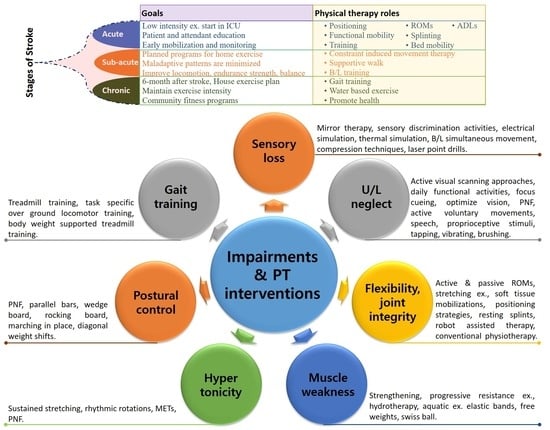A Comprehensive Review of Physical Therapy Interventions for Stroke Rehabilitation: Impairment-Based Approaches and Functional Goals
Abstract
1. Introduction
2. Methodology
3. Framework for Rehabilitation
3.1. Acute Phase
3.2. Sub-Acute Phase
3.3. Chronic Phase
4. Physical Therapy Interventions
4.1. Stages of Motor Recovery
4.2. Strategies to Improve Motor Learning
4.3. Interventions to Improve Sensory Function
4.4. Interventions to Improve Hemianopsia and Unilateral Neglect
4.5. Interventions to Improve Flexibility and Joint Integrity
4.6. Interventions to Improve Strength
4.7. Interventions to Improve Hypertonicity
4.8. Interventions to Improve Postural Control and Balance
4.9. Gait Training
5. Discussion
6. Conclusions
Author Contributions
Funding
Institutional Review Board Statement
Informed Consent Statement
Data Availability Statement
Acknowledgments
Conflicts of Interest
References
- Wang, Q.; Wang, K.; Ma, Y.; Li, S.; Xu, Y. Serum Galectin-3 as a Potential Predictive Biomarker Is Associated with Poststroke Cognitive Impairment. Oxidative Med. Cell. Longev. 2021, 2021, 5827812. [Google Scholar] [CrossRef] [PubMed]
- Cheng, J.; Wang, W.; Xu, J.; Yin, L.; Liu, Y.; Wu, J. Trends in Stroke Mortality Rate—China, 2004–2019. China CDC Wkly. 2022, 4, 513–517. [Google Scholar] [CrossRef] [PubMed]
- Saunders, D.H.; Sanderson, M.; Hayes, S.; Johnson, L.; Kramer, S.; Carter, D.D.; Jarvis, H.; Brazzelli, M.; Mead, G.E. Physical Fitness Training for Stroke Patients. Cochrane Database Syst. Rev. 2020, 2020, CD003316. [Google Scholar] [CrossRef]
- Kozyolkin, O.; Kuznietsov, A.; Novikova, L. Prediction of the Lethal Outcome of Acute Recurrent Cerebral Ischemic Hemispheric Stroke. Medicina 2019, 55, 311. [Google Scholar] [CrossRef] [PubMed]
- Lawrence, M.; Lennon, O.; Faulkner, J. Stroke Secondary Prevention: Everyone’s Business. Healthcare 2022, 10, 2236. [Google Scholar] [CrossRef]
- Govaert, P.; Ramenghi, L.; Taal, R.; De Vries, L.; DeVeber, G. Diagnosis of Perinatal Stroke I: Definitions, Differential Diagnosis and Registration. Acta Paediatr. 2009, 98, 1556–1567. [Google Scholar] [CrossRef]
- Iadecola, C.; Alexander, M. Cerebral Ischemia and Inflammation. Curr. Opin. Neurol. 2001, 14, 89–94. [Google Scholar] [CrossRef]
- Chen, Y.; Luo, Z.; Sun, Y.; Li, F.; Han, Z.; Qi, B.; Lin, J.; Lin, W.-W.; Yao, M.; Kang, X.; et al. Exercise Improves Choroid Plexus Epithelial Cells Metabolism to Prevent Glial Cell-Associated Neurodegeneration. Front. Pharmacol. 2022, 13, 1010785. [Google Scholar] [CrossRef]
- Maalouf, E.; Hallit, S.; Salameh, P.; Hosseini, H. Eating Behaviors, Lifestyle, and Ischemic Stroke: A Lebanese Case-Control Study. Int. J. Environ. Res. Public Health 2023, 20, 1487. [Google Scholar] [CrossRef]
- Chen, Y.; Sun, Y.; Luo, Z.; Chen, X.; Wang, Y.; Qi, B.; Lin, J.; Lin, W.-W.; Sun, C.; Zhou, Y.; et al. Exercise Modifies the Transcriptional Regulatory Features of Monocytes in Alzheimer’s Patients: A Multi-Omics Integration Analysis Based on Single Cell Technology. Front. Aging Neurosci. 2022, 14, 427. [Google Scholar] [CrossRef]
- Patten, C.; Lexell, J.; Brown, H.E. Weakness and Strength Training in Persons with Poststroke Hemiplegia: Rationale, Method, and Efficacy. J. Rehabil. Res. Dev. 2004, 41, 20. [Google Scholar] [CrossRef] [PubMed]
- Rensink, M.; Schuurmans, M.; Lindeman, E.; Hafsteinsdóttir, T. Task-Oriented Training in Rehabilitation after Stroke: Systematic Review. J. Adv. Nurs. 2009, 65, 737–754. [Google Scholar] [CrossRef]
- Saka, Ö.; McGuire, A.; Wolfe, C. Cost of Stroke in the United Kingdom. Age Ageing 2009, 38, 27–32. [Google Scholar] [CrossRef] [PubMed]
- Evers, S.M.A.A.; Struijs, J.N.; Ament, A.J.H.A.; van Genugten, M.L.L.; Jager, J.; Hans, C.; van den Bos, G.A.M. International Comparison of Stroke Cost Studies. Stroke 2004, 35, 1209–1215. [Google Scholar] [CrossRef] [PubMed]
- Wolfe, C.D.A.; Rudd, A.G.; Howard, R.; Coshall, C.; Stewart, J.; Lawrence, E.; Hajat, C.; Hillen, T. Incidence and Case Fatality Rates of Stroke Subtypes in a Multiethnic Population: The South London Stroke Register. J. Neurol. Neurosurg. Psychiatry 2002, 72, 211–216. [Google Scholar] [CrossRef] [PubMed]
- Broderick, J.P.; Phillips, S.J.; Whisnant, J.P.; O’Fallon, W.M.; Bergstralh, E.J. Incidence Rates of Stroke in the Eighties: The End of the Decline in Stroke? Stroke 1989, 20, 577–582. [Google Scholar] [CrossRef]
- James, A.H.; Bushnell, C.D.; Jamison, M.G.; Myers, E.R. Incidence and Risk Factors for Stroke in Pregnancy and the Puerperium. Obstet. Gynecol. 2005, 106, 509–516. [Google Scholar] [CrossRef]
- Wang, W.; Jiang, B.; Sun, H.; Ru, X.; Sun, D.; Wang, L.; Wang, L.; Jiang, Y.; Li, Y.; Wang, Y.; et al. Prevalence, Incidence, and Mortality of Stroke in China. Circulation 2017, 135, 759–771. [Google Scholar] [CrossRef]
- Park, J.E. Identifying Nursing Interventions Captured in Patients with Stroke by Korean Nursing Students: Nursing Interventions Classification Study. J. Korean Gerontol. Nurs. 2023, 25, 69–75. [Google Scholar] [CrossRef]
- Langton-Frost, N.; Orient, S.; Adeyemo, J.; Bahouth, M.N.; Daley, K.; Ye, B.; Lavezza, A.; Pruski, A. Development and Implementation of a New Model of Care for Patients With Stroke, Acute Hospital Rehabilitation Intensive SErvices: Leveraging a Multidisciplinary Rehabilitation Team. Am. J. Phys. Med. Rehabil. 2023, 102, S13–S18. [Google Scholar] [CrossRef]
- Richards, L.G.; Cramer, S.C. Therapies Targeting Stroke Recovery. Stroke 2023, 54, 265–269. [Google Scholar] [CrossRef] [PubMed]
- Batool, A.; Kashif, A.; Nawaz, M.H.; Khan, A.A.; Iqbal, N.; Shahid, M.K. Global Overview of SARS-CoV-2 Induced COVID-19 in 2020: Biological Characterization, Epidemiology with Social, Economic and Environmental Implications. RADS J. Biol. Res. Appl. Sci. 2022, 13, 83–122. [Google Scholar] [CrossRef]
- Edelstein, J.; Kinney, A.R.; Keeney, T.; Hoffman, A.; Graham, J.E.; Malcolm, M.P. Identification of Disability Subgroups for Patients After Ischemic Stroke. Phys. Ther. Rehabil. J. 2023, 103, pzad001. [Google Scholar] [CrossRef]
- Feng, F.; Luo, X.-C.; Chen, Y.-J.; Li, J.-J.; Kang, H.; Yan, B.-H. Effects of Tai Chi Yunshou on Upper-Limb Function and Balance in Stroke Survivors: A Systematic Review and Meta-Analysis. Complement. Ther. Clin. Pract. 2023, 51, 101741. [Google Scholar] [CrossRef]
- Shen, J.; Gu, X.; Yao, Y.; Li, L.; Shi, M.; Li, H.; Sun, Y.; Bai, H.; Li, Y.; Fu, J. Effects of Virtual Reality–Based Exercise on Balance in Patients With Stroke: A Systematic Review and Meta-Analysis. Am. J. Phys. Med. Rehabil. 2023, 102, 316–322. [Google Scholar] [CrossRef]
- O’Brien, S.R.; Barry, M.; Davidson, E.; Porzi, L.; Spink, M.; Weatherbee, D. Physical Therapist Clinical Reasoning in Home Care for Walking Assistive Device Prescription: A Description of Practice. Physiother. Theory Pract. 2023, 39, 80–88. [Google Scholar] [CrossRef]
- McAndrew, E.; McDermott, S.; Vitzakovitch, S.; Warunek, M.; Holm, M.B. Therapist and Patient Perceptions of the Occupational Therapy Goal-Setting Process. Phys. Occup. Ther. Geriatr. 2000, 17, 55–63. [Google Scholar] [CrossRef]
- Simning, A.; Caprio, T.V.; Lam, K. Older Adults Receiving Rehabilitation Services Are More Likely to Get Bathing and Toileting Equipment Installed. Am. J. Occup. Ther. 2023, 77, 7701345010. [Google Scholar] [CrossRef]
- de Sire, A.; Baricich, A.; Ferrillo, M.; Migliario, M.; Cisari, C.; Invernizzi, M. Buccal Hemineglect: Is It Useful to Evaluate the Differences between the Two Halves of the Oral Cavity for the Multidisciplinary Rehabilitative Management of Right Brain Stroke Survivors? A Cross-Sectional Study. Top. Stroke Rehabil. 2020, 27, 208–214. [Google Scholar] [CrossRef]
- Marzouqah, R.; Huynh, A.; Chen, J.L.; Boulos, M.I.; Yunusova, Y. The Role of Oral and Pharyngeal Motor Exercises in Post-Stroke Recovery: A Scoping Review. Clin. Rehabil. 2022, 37, 620–635. [Google Scholar] [CrossRef]
- Piccolo, A.; Corallo, F.; Cardile, D.; Torrisi, M.; Smorto, C.; Cammaroto, S.; Lo Buono, V. Music Therapy in Global Aphasia: A Case Report. Medicines 2023, 10, 16. [Google Scholar] [CrossRef]
- Marinho-Buzelli, A.R.; Vijayakumar, A.; Linkewich, E.; Gareau, C.; Mawji, H.; Li, Z.; Hitzig, S.L. A Qualitative Pilot Study Exploring Clients’ and Health-Care Professionals’ Experiences with Aquatic Therapy Post-Stroke in Ontario, Canada. Top. Stroke Rehabil. 2023, 1–13. [Google Scholar] [CrossRef] [PubMed]
- Kayola, G.; Mataa, M.M.; Asukile, M.; Chishimba, L.; Chomba, M.; Mortel, D.; Nutakki, A.; Zimba, S.; Saylor, D. Stroke Rehabilitation in Low- and Middle-Income Countries: Challenges and Opportunities. Am. J. Phys. Med. Rehabil. 2023, 102, S24–S32. [Google Scholar] [CrossRef] [PubMed]
- Dobkin, B.H. Focused Stroke Rehabilitation Programs Do Not Improve Outcome. Arch. Neurol. 1989, 46, 701–703. [Google Scholar] [CrossRef] [PubMed]
- Langhorne, P. Collaborative Systematic Review of the Randomised Trials of Organised Inpatient (Stroke Unit) Care after Stroke. BMJ 1997, 314, 1151. [Google Scholar] [CrossRef]
- Bernhardt, J.; Godecke, E.; Johnson, L.; Langhorne, P. Early Rehabilitation after Stroke. Curr. Opin. Neurol. 2017, 30, 48–54. [Google Scholar] [CrossRef] [PubMed]
- Poletto, S.R.; Rebello, L.C.; Valença, M.J.M.; Rossato, D.; Almeida, A.G.; Brondani, R.; Chaves, M.L.F.; Nasi, L.A.; Martins, S.C.O. Early Mobilization in Ischemic Stroke: A Pilot Randomized Trial of Safety and Feasibility in a Public Hospital in Brazil. Cerebrovasc. Dis. Extra 2015, 5, 31–40. [Google Scholar] [CrossRef]
- Castellini, G.; Gianola, S.; Banzi, R.; Corbetta, D.; Gatti, R.; Sirtori, V.; Gluud, C.; Moja, L. Constraint-Induced Movement Therapy: Trial Sequential Analysis Applied to Cochrane Collaboration Systematic Review Results. Trials 2014, 15, 512. [Google Scholar] [CrossRef][Green Version]
- Van Peppen, R.P.S.; Kwakkel, G.; Wood-Dauphinee, S.; Hendriks, H.J.M.; Van der Wees, P.J.; Dekker, J. The Impact of Physical Therapy on Functional Outcomes after Stroke: What’s the Evidence? Clin. Rehabil. 2004, 18, 833–862. [Google Scholar] [CrossRef]
- De Wit, L.; Putman, K.; Dejaeger, E.; Baert, I.; Berman, P.; Bogaerts, K.; Brinkmann, N.; Connell, L.; Feys, H.; Jenni, W.; et al. Use of Time by Stroke Patients. Stroke 2005, 36, 1977–1983. [Google Scholar] [CrossRef]
- Panel, O. Ottawa Panel Evidence-Based Clinical Practice Guidelines for Post-Stroke Rehabilitation. Top. Stroke Rehabil. 2006, 13, 1–269. [Google Scholar] [CrossRef] [PubMed]
- Mayo, N.E.; Wood-Dauphinee, S.; Ahmed, S.; Gordon, C.; Higgins, J.; Mcewen, S.; Salbach, N. Disablement Following Stroke. Disabil. Rehabil. 1999, 21, 258–268. [Google Scholar] [CrossRef] [PubMed]
- Winter, J.; Hunter, S.; Sim, J.; Crome, P. Hands-on Therapy Interventions for Upper Limb Motor Dysfunction Following Stroke. Cochrane Database Syst. Rev. 2011, 2011, CD006609. [Google Scholar] [CrossRef]
- Brunner, I.; Skouen, J.S.; Hofstad, H.; Aßmus, J.; Becker, F.; Sanders, A.-M.; Pallesen, H.; Kristensen, L.Q.; Michielsen, M.; Thijs, L.; et al. Virtual Reality Training for Upper Extremity in Subacute Stroke (VIRTUES) A Multicenter RCT. Neurology 2017, 89, 2413–2421. [Google Scholar] [CrossRef] [PubMed]
- Pollock, A.; Baer, G.; Langhorne, P.; Pomeroy, V. Physiotherapy Treatment Approaches for the Recovery of Postural Control and Lower Limb Function Following Stroke: A Systematic Review. Clin. Rehabil. 2007, 21, 395–410. [Google Scholar] [CrossRef]
- Ward, N.S.; Brander, F.; Kelly, K. Intensive Upper Limb Neurorehabilitation in Chronic Stroke: Outcomes from the Queen Square Programme. J. Neurol. Neurosurg. Psychiatry 2019, 90, 498–506. [Google Scholar] [CrossRef]
- Daly, J.J.; McCabe, J.P.; Holcomb, J.; Monkiewicz, M.; Gansen, J.; Pundik, S. Long-Dose Intensive Therapy Is Necessary for Strong, Clinically Significant, Upper Limb Functional Gains and Retained Gains in Severe/Moderate Chronic Stroke. Neurorehabil. Neural Repair 2019, 33, 523–537. [Google Scholar] [CrossRef]
- Sütbeyaz, S.; Yavuzer, G.; Sezer, N.; Koseoglu, B.F. Mirror Therapy Enhances Lower-Extremity Motor Recovery and Motor Functioning After Stroke: A Randomized Controlled Trial. Arch. Phys. Med. Rehabil. 2007, 88, 555–559. [Google Scholar] [CrossRef]
- Eser, F.; Yavuzer, G.; Karakus, D.; Karaoglan, B. The Effect of Balance Training on Motor Recovery and Ambulation after Stroke: A Randomized Controlled Trial. Eur. J. Phys. Rehabil. Med. 2008, 44, 19–25. [Google Scholar]
- Ietswaart, M.; Johnston, M.; Dijkerman, H.C.; Joice, S.; Scott, C.L.; MacWalter, R.S.; Hamilton, S.J.C. Mental Practice with Motor Imagery in Stroke Recovery: Randomized Controlled Trial of Efficacy. Brain 2011, 134, 1373–1386. [Google Scholar] [CrossRef]
- Doyle, S.; Bennett, S.; Fasoli, S.E.; McKenna, K.T. Interventions for Sensory Impairment in the Upper Limb after Stroke. Cochrane Database Syst. Rev. 2010, 2010, CD006331. [Google Scholar] [CrossRef]
- Carey, L. Review on Somatosensory Loss after Stroke. Crit. Rev. Phys. Rehabil. Med. 2017, 29, 1–46. [Google Scholar] [CrossRef]
- Byl, N.; Roderick, J.; Mohamed, O.; Hanny, M.; Kotler, J.; Smith, A.; Tang, M.; Abrams, G. Effectiveness of Sensory and Motor Rehabilitation of the Upper Limb Following the Principles of Neuroplasticity: Patients Stable Poststroke. Neurorehabil. Neural Repair 2003, 17, 176–191. [Google Scholar] [CrossRef] [PubMed]
- Cambier, D.C.; De Corte, E.; Danneels, L.A.; Witvrouw, E.E. Treating Sensory Impairments in the Post-Stroke Upper Limb with Intermittent Pneumatic Compression. Results of a Preliminary Trial. Clin. Rehabil. 2003, 17, 14–20. [Google Scholar] [CrossRef]
- Bailey, M.J.; Riddoch, M.J.; Crome, P. Treatment of Visual Neglect in Elderly Patients With Stroke: A Single-Subject Series Using Either a Scanning and Cueing Strategy or a Left-Limb Activation Strategy. Phys. Ther. 2002, 82, 782–797. [Google Scholar] [CrossRef]
- Wiart, L.; Côme, A.B.S.; Debelleix, X.; Petit, H.; Joseph, P.A.; Mazaux, J.M.; Barat, M. Unilateral Neglect Syndrome Rehabilitation by Trunk Rotation and Scanning Training. Arch. Phys. Med. Rehabil. 1997, 78, 424–429. [Google Scholar] [CrossRef] [PubMed]
- Parikh, R.J.; Sutaria, J.M.; Ahsan, M.; Nuhmani, S.; Alghadir, A.H.; Khan, M. Effects of Myofascial Release with Tennis Ball on Spasticity and Motor Functions of Upper Limb in Patients with Chronic Stroke: A Randomized Controlled Trial. Medicine 2022, 101, e29926. [Google Scholar] [CrossRef] [PubMed]
- Cho, K.-H.; Hong, M.-R.; Song, W.-K. Upper-Limb Robot-Assisted Therapy Based on Visual Error Augmentation in Virtual Reality for Motor Recovery and Kinematics after Chronic Hemiparetic Stroke: A Feasibility Study. Healthcare 2022, 10, 1186. [Google Scholar] [CrossRef]
- Calafiore, D.; Negrini, F.; Tottoli, N.; Ferraro, F.; Ozyemisci-Taskiran, O.; de Sire, A. Efficacy of Robotic Exoskeleton for Gait Rehabilitation in Patients with Subacute Stroke: A Systematic Review. Eur. J. Phys. Rehabil. Med. 2022, 58, 1–8. [Google Scholar] [CrossRef]
- Zhou, Z.; Sun, Y.; Wang, N.; Gao, F.; Wei, K.; Wang, Q. Robot-Assisted Rehabilitation of Ankle Plantar Flexors Spasticity: A 3-Month Study with Proprioceptive Neuromuscular Facilitation. Front. Neurorobot. 2016, 10, 16. [Google Scholar] [CrossRef]
- Ada, L.; Dorsch, S.; Canning, C.G. Strengthening Interventions Increase Strength and Improve Activity after Stroke: A Systematic Review. Aust. J. Physiother. 2006, 52, 241–248. [Google Scholar] [CrossRef] [PubMed]
- Basmajian, J.V.; Kukulka, C.G.; Narayan, M.G.; Takebe, K. Biofeedback Treatment of Foot-Drop after Stroke Compared with Standard Rehabilitation Technique: Effects on Voluntary Control and Strength. Arch. Phys. Med. Rehabil. 1975, 56, 231–236. [Google Scholar] [PubMed]
- Lee, J.; Yu, J.; Hong, J.; Lee, D.; Kim, J.; Kim, S. The Effect of Augmented Reality-Based Proprioceptive Training Program on Balance, Positioning Sensation and Flexibility in Healthy Young Adults: A Randomized Controlled Trial. Healthcare 2022, 10, 1202. [Google Scholar] [CrossRef] [PubMed]
- Dobkin, B.H. Strategies for Stroke Rehabilitation. Lancet Neurol. 2004, 3, 528–536. [Google Scholar] [CrossRef]
- Sommerfeld, D.K.; Eek, E.U.-B.; Svensson, A.-K.; Holmqvist, L.W.; von Arbin, M.H. Spasticity After Stroke. Stroke 2004, 35, 134–139. [Google Scholar] [CrossRef]
- Zackowski, K.M.; Dromerick, A.W.; Sahrmann, S.A.; Thach, W.T.; Bastian, A.J. How Do Strength, Sensation, Spasticity and Joint Individuation Relate to the Reaching Deficits of People with Chronic Hemiparesis? Brain 2004, 127, 1035–1046. [Google Scholar] [CrossRef]
- Smith, G.R.; Frost, C.D.; Aguirre, A.T. Botulinum Toxin Injections for Muscle Spasticity BT-Bedside Pain Management Interventions. In Bedside Pain Management Interventions; Souza, D., Kohan, L.R., Eds.; Springer International Publishing: Cham, Switzerland, 2022; pp. 641–663. ISBN 978-3-031-11188-4. [Google Scholar]
- Baricich, A.; Picelli, A.; Santamato, A.; Carda, S.; de Sire, A.; Smania, N.; Cisari, C.; Invernizzi, M. Safety Profile of High-Dose Botulinum Toxin Type A in Post-Stroke Spasticity Treatment. Clin. Drug Investig. 2018, 38, 991–1000. [Google Scholar] [CrossRef]
- Gracies, J.-M. Pathophysiology of Impairment in Patients with Spasticity and Use of Stretch as a Treatment of Spastic Hypertonia. Phys. Med. Rehabil. Clin. N. Am. 2001, 12, 747–768. [Google Scholar] [CrossRef]
- Brashear, A.; Gordon, M.F.; Elovic, E.; Kassicieh, V.D.; Marciniak, C.; Do, M.; Lee, C.-H.; Jenkins, S.; Turkel, C. Intramuscular Injection of Botulinum Toxin for the Treatment of Wrist and Finger Spasticity after a Stroke. N. Engl. J. Med. 2002, 347, 395–400. [Google Scholar] [CrossRef]
- Nguyen, P.T.; Chou, L.-W.; Hsieh, Y.-L. Proprioceptive Neuromuscular Facilitation-Based Physical Therapy on the Improvement of Balance and Gait in Patients with Chronic Stroke: A Systematic Review and Meta-Analysis. Life 2022, 12, 882. [Google Scholar] [CrossRef]
- Kim, B.H.; Lee, S.M.; Bae, Y.H.; Yu, J.H.; Kim, T.H. The Effect of a Task-Oriented Training on Trunk Control Ability, Balance and Gait of Stroke Patients. J. Phys. Ther. Sci. 2012, 24, 519–522. [Google Scholar] [CrossRef]
- Lee, M.-M.; Shin, D.-C.; Song, C.-H. Canoe Game-Based Virtual Reality Training to Improve Trunk Postural Stability, Balance, and Upper Limb Motor Function in Subacute Stroke Patients: A Randomized Controlled Pilot Study. J. Phys. Ther. Sci. 2016, 28, 2019–2024. [Google Scholar] [CrossRef] [PubMed]
- Glowinski, S.; Blazejewski, A. SPIDER as A Rehabilitation Tool for Patients with Neurological Disabilities: The Preliminary Research. J. Pers. Med. 2020, 10, 33. [Google Scholar] [CrossRef] [PubMed]
- Zech, A.; Hübscher, M.; Vogt, L.; Banzer, W.; Hänsel, F.; Pfeifer, K. Balance Training for Neuromuscular Control and Performance Enhancement: A Systematic Review. J. Athl. Train. 2010, 45, 392–403. [Google Scholar] [CrossRef] [PubMed]
- Lord, S.E.; McPherson, K.; McNaughton, H.K.; Rochester, L.; Weatherall, M. Community Ambulation after Stroke: How Important and Obtainable Is It and What Measures Appear Predictive?11No Commercial Party Having a Direct Financial Interest in the Results of the Research Supporting This Article Has or Will Confer a Benefit on the A. Arch. Phys. Med. Rehabil. 2004, 85, 234–239. [Google Scholar] [CrossRef] [PubMed]
- Jørgensen, H.S.; Nakayama, H.; Raaschou, H.O.; Olsen, T.S. Recovery of Walking Function in Stroke Patients: The Copenhagen Stroke Study. Arch. Phys. Med. Rehabil. 1995, 76, 27–32. [Google Scholar] [CrossRef]
- Perry, J.; Garrett, M.; Gronley, J.K.; Mulroy, S.J. Classification of Walking Handicap in the Stroke Population. Stroke 1995, 26, 982–989. [Google Scholar] [CrossRef] [PubMed]
- Dean, C.M.; Richards, C.L.; Malouin, F. Task-Related Circuit Training Improves Performance of Locomotor Tasks in Chronic Stroke: A Randomized, Controlled Pilot Trial. Arch. Phys. Med. Rehabil. 2000, 81, 409–417. [Google Scholar] [CrossRef]
- Dam, M.; Tonin, P.; Casson, S.; Ermani, M.; Pizzolato, G.; Iaia, V.; Battistin, L. The Effects of Long-Term Rehabilitation Therapy on Poststroke Hemiplegic Patients. Stroke 1993, 24, 1186–1191. [Google Scholar] [CrossRef]
- Werner, C.; Bardeleben, A.; Mauritz, K.-H.; Kirker, S.; Hesse, S. Treadmill Training with Partial Body Weight Support and Physiotherapy in Stroke Patients: A Preliminary Comparison. Eur. J. Neurol. 2002, 9, 639–644. [Google Scholar] [CrossRef]
- Casamassima, F.; Ferrari, A.; Milosevic, B.; Ginis, P.; Farella, E.; Rocchi, L. A Wearable System for Gait Training in Subjects with Parkinson’s Disease. Sensors 2014, 14, 6229–6246. [Google Scholar] [CrossRef] [PubMed]
- Bui, J.; Luauté, J.; Farnè, A. Enhancing Upper Limb Rehabilitation of Stroke Patients With Virtual Reality: A Mini Review. Front. Virtual Real. 2021, 2, 595771. [Google Scholar] [CrossRef]
- Green, J.; Forster, A.; Bogle, S.; Young, J. Physiotherapy for Patients with Mobility Problems More than 1 Year after Stroke: A Randomised Controlled Trial. Lancet 2002, 359, 199–203. [Google Scholar] [CrossRef] [PubMed]
- Macko, R.F.; Smith, G.V.; Dobrovolny, C.L.; Sorkin, J.D.; Goldberg, A.P.; Silver, K.H. Treadmill Training Improves Fitness Reserve in Chronic Stroke Patients. Arch. Phys. Med. Rehabil. 2001, 82, 879–884. [Google Scholar] [CrossRef] [PubMed]
- Sullivan, K.J.; Knowlton, B.J.; Dobkin, B.H. Step Training with Body Weight Support: Effect of Treadmill Speed and Practice Paradigms on Poststroke Locomotor Recovery. Arch. Phys. Med. Rehabil. 2002, 83, 683–691. [Google Scholar] [CrossRef]
- Ada, L.; Dean, C.M.; Hall, J.M.; Bampton, J.; Crompton, S. A Treadmill and Overground Walking Program Improves Walking in Persons Residing in the Community after Stroke: A Placebo-Controlled, Randomized Trial 11No Commercial Party Having a Direct Financial Interest in the Results of the Research Supporting This A. Arch. Phys. Med. Rehabil. 2003, 84, 1486–1491. [Google Scholar] [CrossRef]
- Ray, N.T.; Reisman, D.S.; Higginson, J.S. Combined User-Driven Treadmill Control and Functional Electrical Stimulation Increases Walking Speeds Poststroke. J. Biomech. 2021, 124, 110480. [Google Scholar] [CrossRef]
- Yagura, H.; Miyai, I.; Seike, Y.; Suzuki, T.; Yanagihara, T. Benefit of Inpatient Multidisciplinary Rehabilitation up to 1 Year after Stroke11No Commercial Party Having a Direct Financial Interest in the Results of the Research Supporting This Article Has or Will Confer a Benefit upon the Author(s) or upon Any Orga. Arch. Phys. Med. Rehabil. 2003, 84, 1687–1691. [Google Scholar] [CrossRef]
- Olney, S.J.; Griffin, M.P.; Monga, T.N.; McBride, I.D. Work and Power in Gait of Stroke Patients. Arch. Phys. Med. Rehabil. 1991, 72, 309–314. [Google Scholar] [CrossRef]
- Yelnik, A. Récupération de La Motricité Après Accident Vasculaire Cérébral. Facteurs Pronostiques et Rééducation. Bull. Acad. Natl. Med. 2022, 206, 594–603. [Google Scholar] [CrossRef]
- Knutsson, E. Gait Control in Hemiparesis. Scand. J. Rehabil. Med. 1981, 13, 101–108. [Google Scholar] [PubMed]
- Yagura, H.; Hatakenaka, M.; Miyai, I. Does Therapeutic Facilitation Add to Locomotor Outcome of Body Weight−Supported Treadmill Training in Nonambulatory Patients With Stroke? A Randomized Controlled Trial. Arch. Phys. Med. Rehabil. 2006, 87, 529–535. [Google Scholar] [CrossRef] [PubMed]
- Choi, W. Effects of Robot-Assisted Gait Training with Body Weight Support on Gait and Balance in Stroke Patients. Int. J. Environ. Res. Public Health 2022, 19, 5814. [Google Scholar] [CrossRef] [PubMed]
- Hassid, E.; Rose, D.; Commisarow, J.; Guttry, M.; Dobkin, B.H. Improved Gait Symmetry in Hemiparetic Stroke Patients Induced During Body Weight-Supported Treadmill Stepping. J. Neurol. Rehabil. 1997, 11, 21–26. [Google Scholar] [CrossRef]
- Nakayama, H.; Stig Jørgensen, H.; Otto Raaschou, H.; Skyhøj Olsen, T. Recovery of Upper Extremity Function in Stroke Patients: The Copenhagen Stroke Study. Arch. Phys. Med. Rehabil. 1994, 75, 394–398. [Google Scholar] [CrossRef]
- Wade, D.T.; Wood, V.A.; Heller, A.; Maggs, J.; Langton Hewer, R. Walking after Stroke. Measurement and Recovery over the First 3 Months. Scand. J. Rehabil. Med. 1987, 19, 25–30. [Google Scholar]
- Ventura, J.D.; Charrette, A.L.; Roberts, K.J. The Effect of a Low-Cost Body Weight-Supported Treadmill Trainer on Walking Speed and Joint Motion. Medicina 2019, 55, 420. [Google Scholar] [CrossRef]
- Feigin, V.L. Stroke Epidemiology in the Developing World. Lancet 2005, 365, 2160–2161. [Google Scholar] [CrossRef]
- Zhang, S.; Xie, H.; Wang, C.; Wu, F.; Wang, X. Effectiveness of Physiotherapy to Promote Motor Recovery in Individuals with Stroke: A Systematic Review Protocol. Res. Square 2022, 1–13. [Google Scholar]
- Gordon, B.R.; McDowell, C.P.; Hallgren, M.; Meyer, J.D.; Lyons, M.; Herring, M.P. Association of Efficacy of Resistance Exercise Training With Depressive Symptoms: Meta-Analysis and Meta-Regression Analysis of Randomized Clinical Trials. JAMA Psychiatry 2018, 75, 566–576. [Google Scholar] [CrossRef]
- Aichner, F.; Adelwöhrer, C.; Haring, H.-P. Rehabilitation Approaches to Stroke BT-Stroke-Vascular Diseases. In Proceedings of the International Journal of Rehabilitation Research; Fleischhacker, W.W., Brooks, D.J., Eds.; Springer Vienna: Vienna, Austria, 2002; pp. 59–73. [Google Scholar]
- Winstein, C.J.; Rose, D.K.; Tan, S.M.; Lewthwaite, R.; Chui, H.C.; Azen, S.P. A Randomized Controlled Comparison of Upper-Extremity Rehabilitation Strategies in Acute Stroke: A Pilot Study of Immediate and Long-Term Outcomes11No Commercial Party Having a Direct Financial Interest in the Results of the Research Supporting This Artic. Arch. Phys. Med. Rehabil. 2004, 85, 620–628. [Google Scholar] [CrossRef] [PubMed]
- Kendall, B.J.; Gothe, N.P. Effect of Aerobic Exercise Interventions on Mobility among Stroke Patients: A Systematic Review. Am. J. Phys. Med. Rehabil. 2016, 95, 214–224. [Google Scholar] [CrossRef] [PubMed]
- Brunelli, S.; Iosa, M.; Fusco, F.R.; Pirri, C.; Di Giunta, C.; Foti, C.; Traballesi, M. Early Body Weight-Supported Overground Walking Training in Patients with Stroke in Subacute Phase Compared to Conventional Physiotherapy: A Randomized Controlled Pilot Study. Int. J. Rehabil. Res. 2019, 42, 309–315. [Google Scholar] [CrossRef] [PubMed]
- Vive, S.; Af Geijerstam, J.-L.; Kuhn, H.G.; Bunketorp-Käll, L. Enriched, Task-Specific Therapy in the Chronic Phase After Stroke: An Exploratory Study. J. Neurol. Phys. Ther. 2020, 44, 145–155. [Google Scholar] [CrossRef] [PubMed]
- Campagnini, S.; Liuzzi, P.; Mannini, A.; Riener, R.; Carrozza, M.C. Effects of Control Strategies on Gait in Robot-Assisted Post-Stroke Lower Limb Rehabilitation: A Systematic Review. J. Neuroeng. Rehabil. 2022, 19, 52. [Google Scholar] [CrossRef] [PubMed]
- Langhorne, P.; Bernhardt, J.; Kwakkel, G. Stroke Rehabilitation. Lancet 2011, 377, 1693–1702. [Google Scholar] [CrossRef]
- Coupar, F.; Pollock, A.; van Wijck, F.; Morris, J.; Langhorne, P. Simultaneous Bilateral Training for Improving Arm Function after Stroke. Cochrane Database Syst. Rev. 2010, 2010, CD006432. [Google Scholar] [CrossRef]
- Langhorne, P.; Collier, J.M.; Bate, P.J.; Thuy, M.N.T.; Bernhardt, J. Very Early versus Delayed Mobilisation after Stroke. Cochrane Database Syst. Rev. 2018, 2018, CD006187. [Google Scholar] [CrossRef]
- Sullivan, J.E.; Hedman, L.D. Sensory Dysfunction Following Stroke: Incidence, Significance, Examination, and Intervention. Top. Stroke Rehabil. 2008, 15, 200–217. [Google Scholar] [CrossRef]
- Jones, S.A.; Shinton, R.A. Improving Outcome in Stroke Patients with Visual Problems. Age Ageing 2006, 35, 560–565. [Google Scholar] [CrossRef]
- Saionz, E.L.; Cavanaugh, M.R.; Johnson, B.A.; Harrington, D.; Aguirre, G.K.; Huxlin, K.R. The Natural History of Homonymous Hemianopia Revisited. medRxiv 2022. [Google Scholar] [CrossRef]
- Shin, H.E.; Kim, M.; Lee, D.; Jang, J.Y.; Soh, Y.; Yun, D.H.; Kim, S.; Yang, J.; Kim, M.K.; Lee, H.; et al. Therapeutic Effects of Functional Electrical Stimulation on Physical Performance and Muscle Strength in Post-Stroke Older Adults: A Review. Ann. Geriatr. Med. Res. 2022, 26, 16–24. [Google Scholar] [CrossRef] [PubMed]
- Mentiplay, B.F.; Adair, B.; Bower, K.J.; Williams, G.; Tole, G.; Clark, R.A. Associations between Lower Limb Strength and Gait Velocity Following Stroke: A Systematic Review. Brain Inj. 2015, 29, 409–422. [Google Scholar] [CrossRef] [PubMed]
- Yoo, S.D.; Choi, M.K.; Kim, D.H.; Lee, S.A.; Chung, S.J.; Park, E.J.; Kim, M.G.; Kim, J.M. Biomechanical Analyses of Gait and Balance in Patients with Subacute Stroke. Res. Square 2022, 1–21. [Google Scholar] [CrossRef]
- Hohl, K.; Giffhorn, M.; Jackson, S.; Jayaraman, A. A Framework for Clinical Utilization of Robotic Exoskeletons in Rehabilitation. J. Neuroeng. Rehabil. 2022, 19, 115. [Google Scholar] [CrossRef]
- Nolan, K.J.; Karunakaran, K.K.; Chervin, K.; Monfett, M.R.; Bapineedu, R.K.; Jasey, N.N.; Oh-Park, M. Robotic Exoskeleton Gait Training during Acute Stroke Inpatient Rehabilitation. Front. Neurorobot. 2020, 14, 581815. [Google Scholar] [CrossRef]
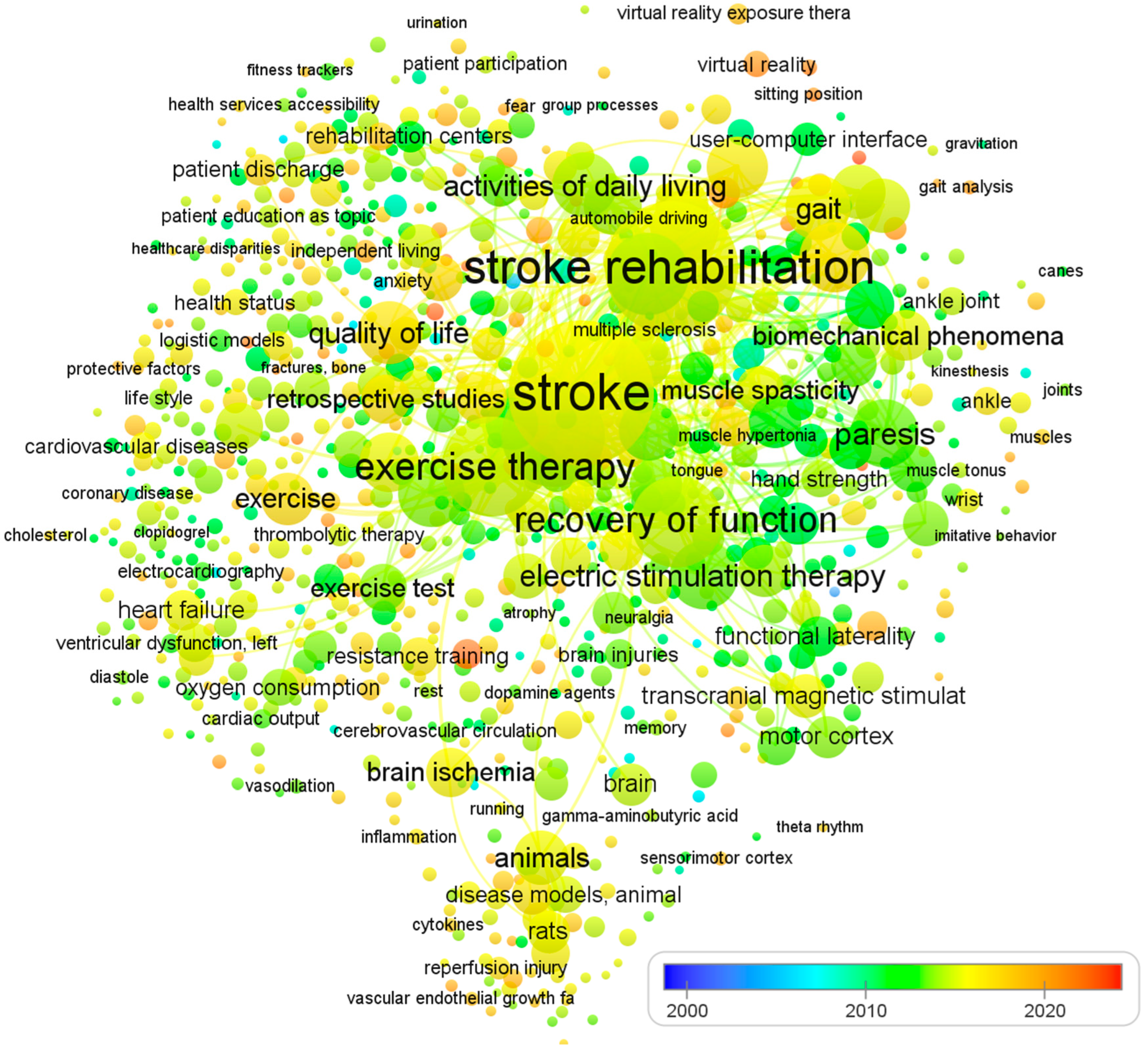
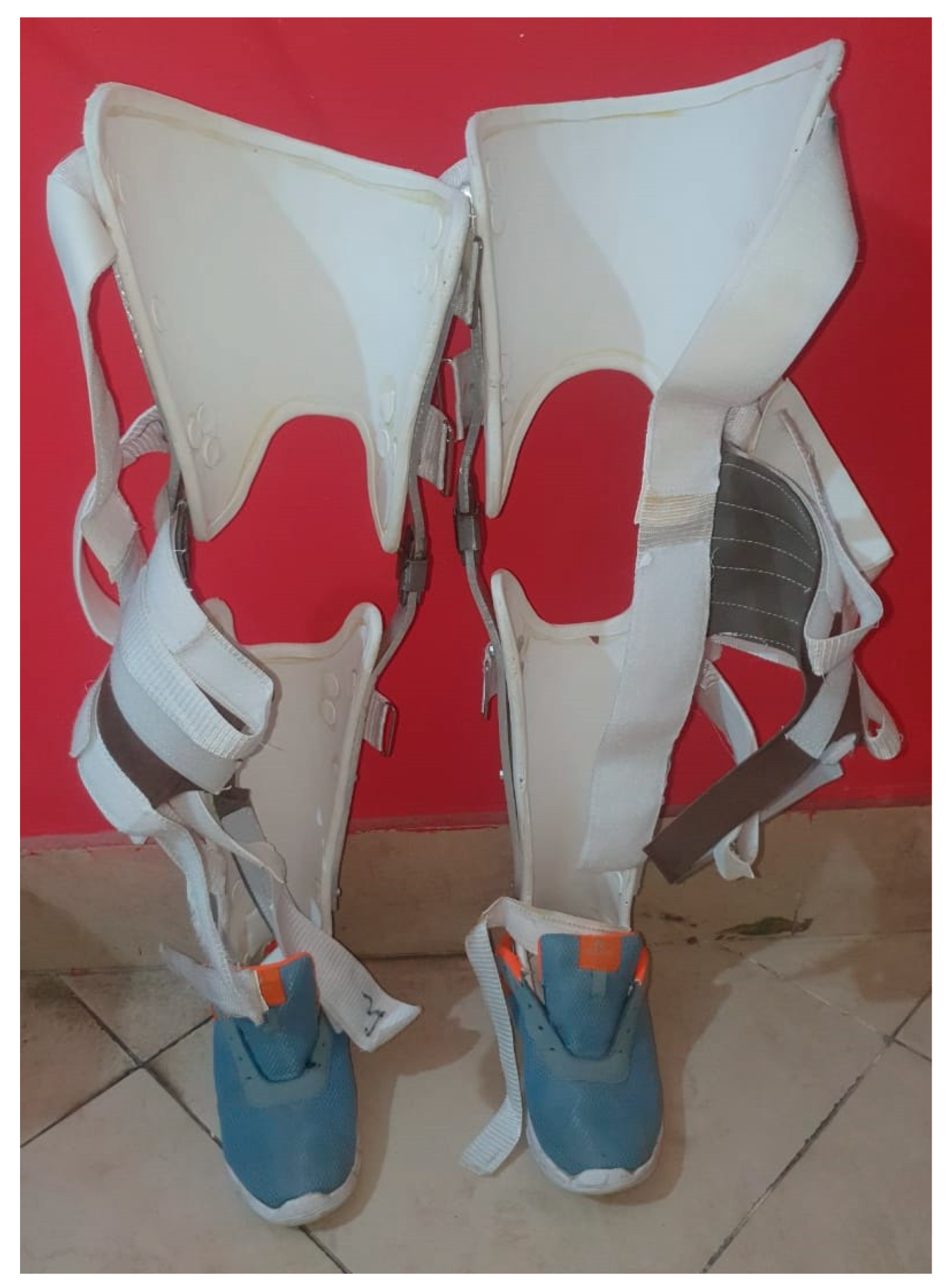

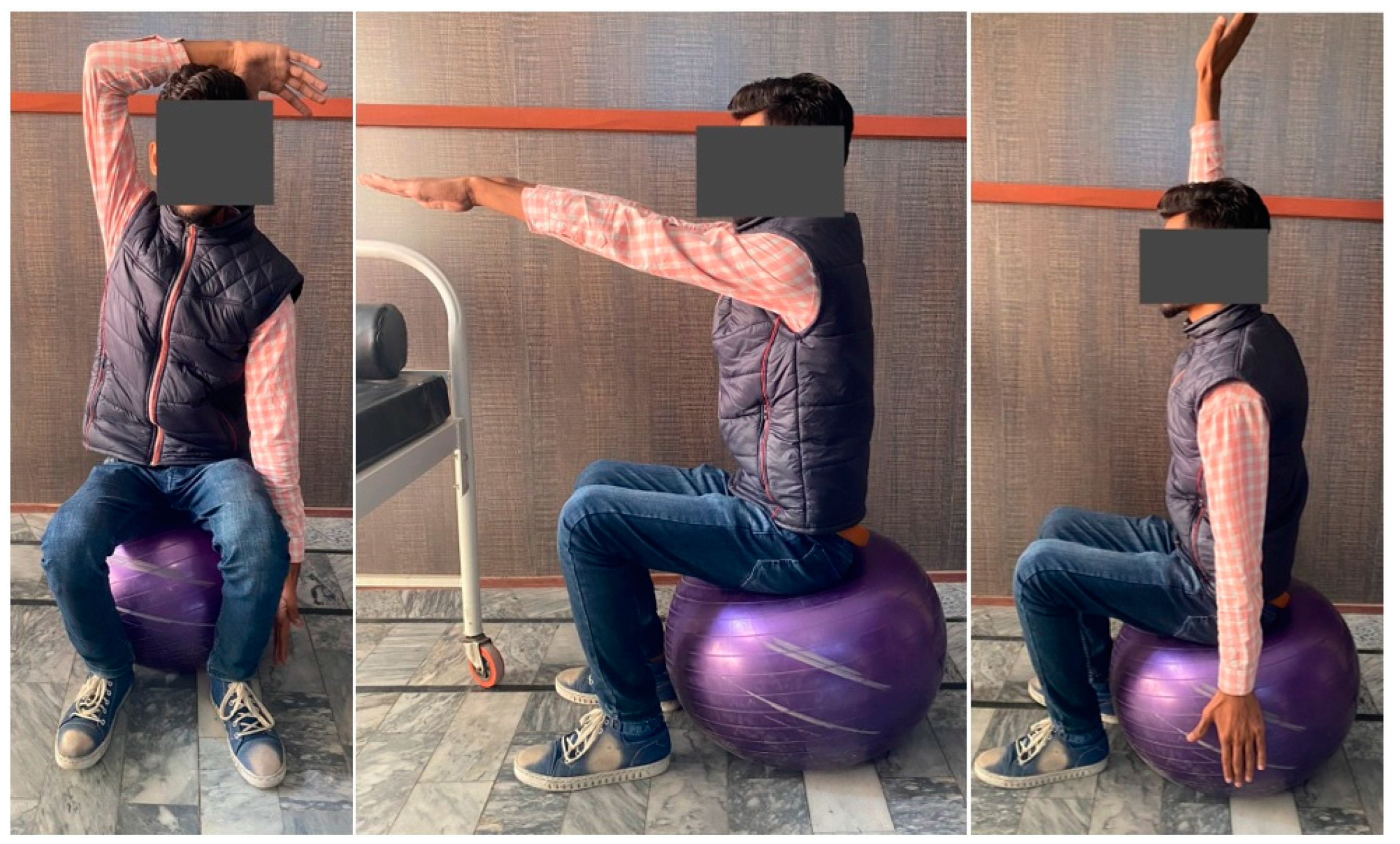
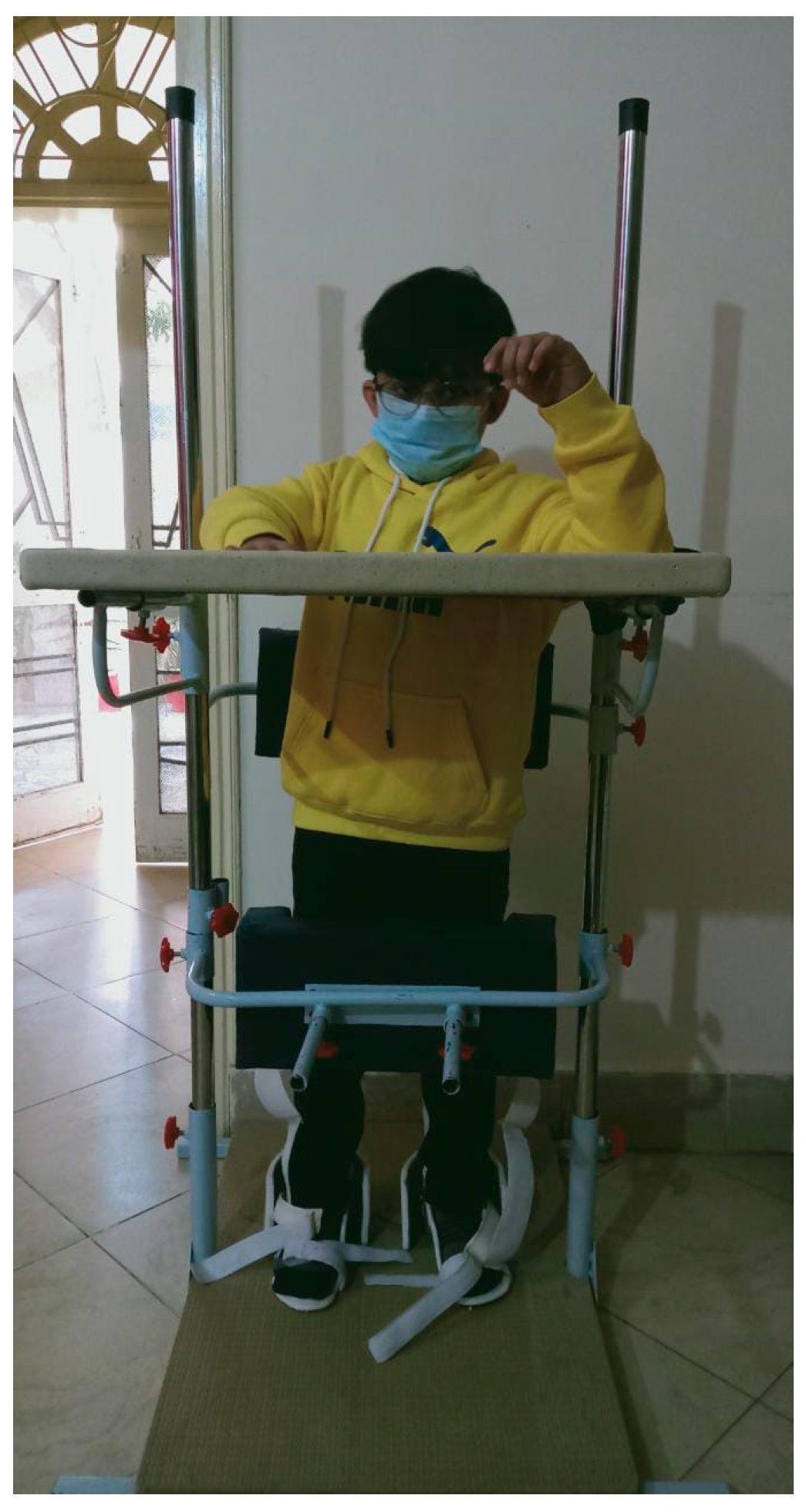
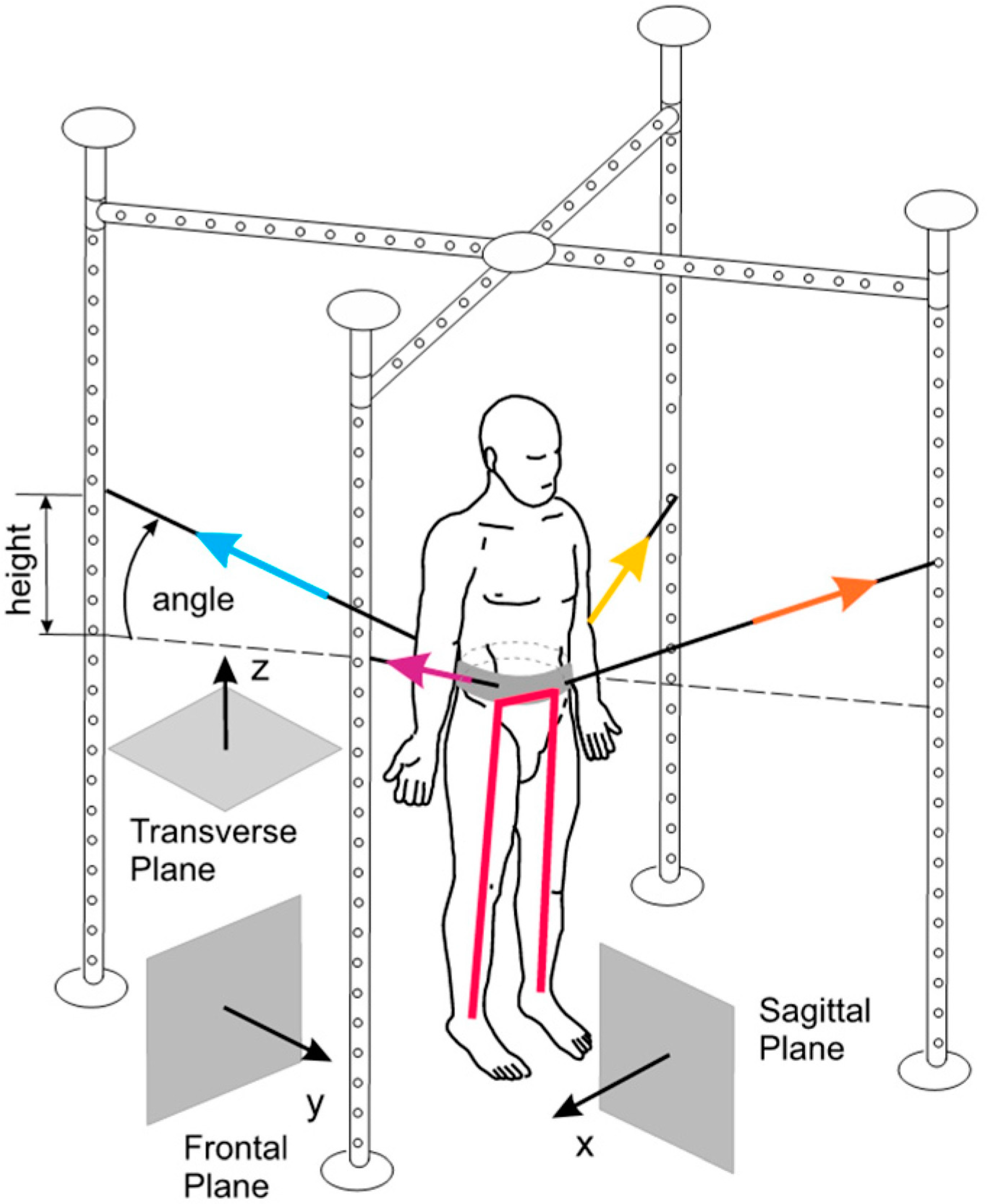

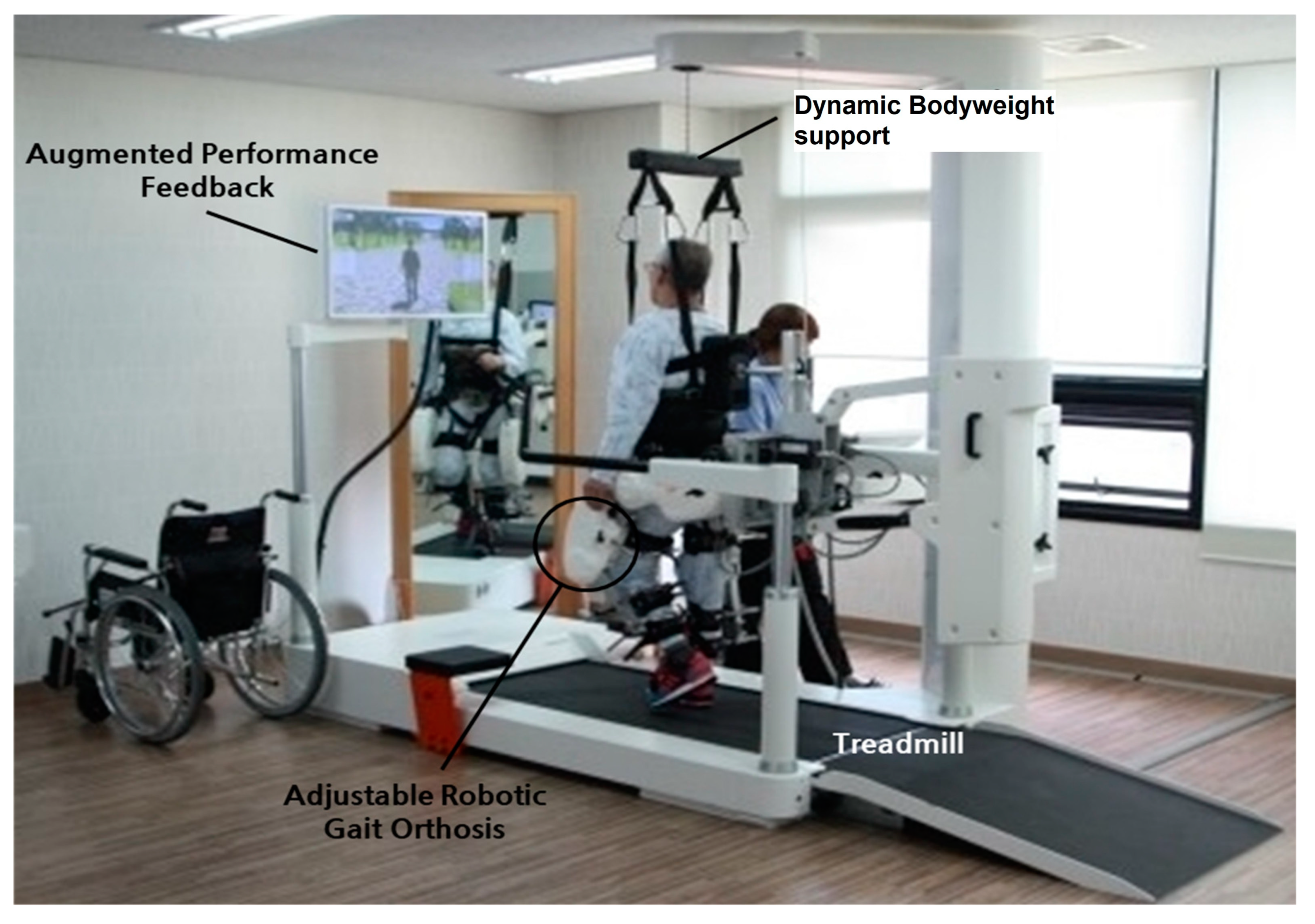
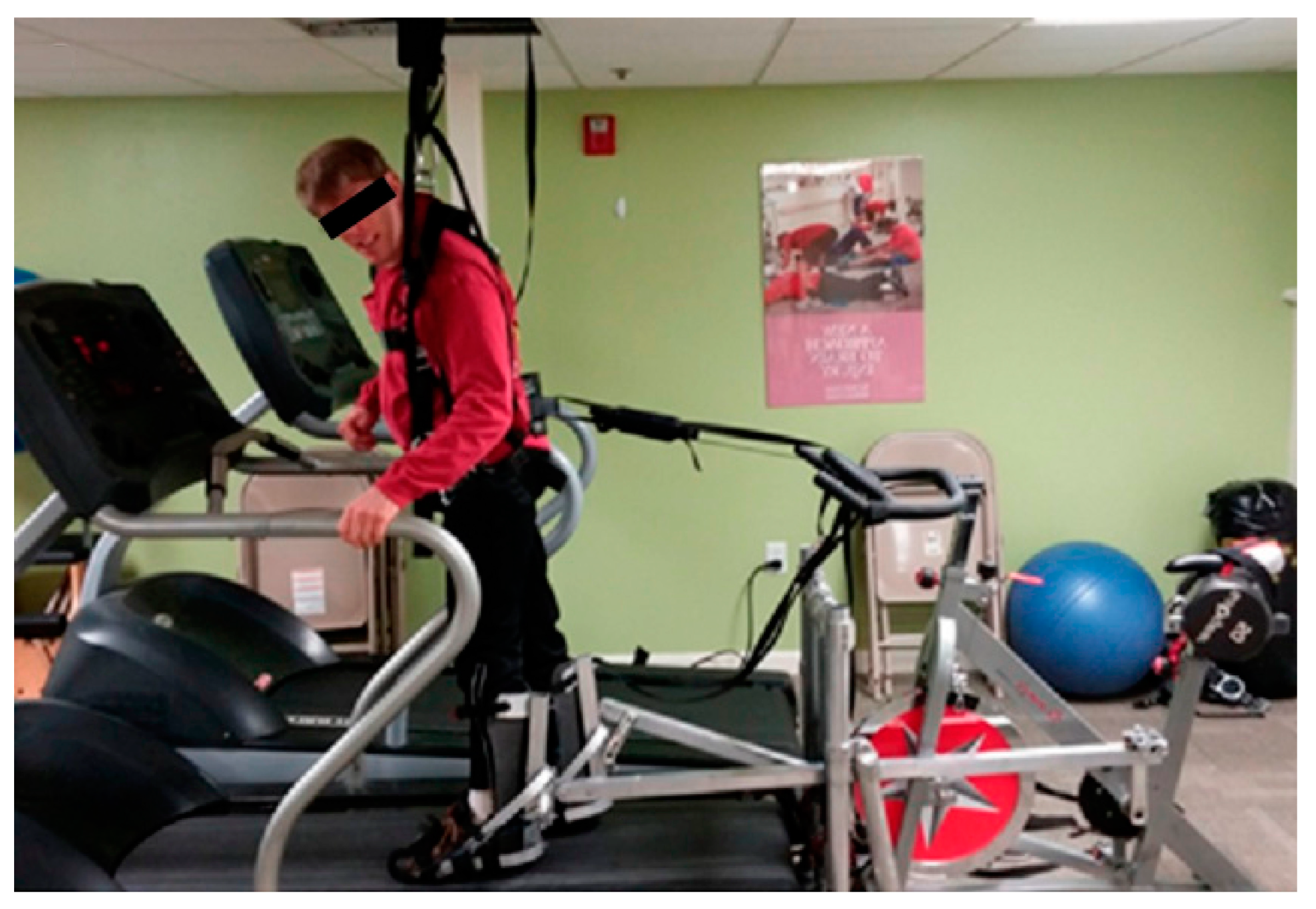
| Inclusion Criteria | Exclusion Criteria |
|---|---|
| Randomized controlled trials, systematic reviews and meta-analyses, experimental studies. | Single case studies, books, theses, editorial letters, conference abstracts. |
| Publications in English. | Studies published in any other language. |
| Fulfil on the PICO format. | Not agreeing with the PICO format. |
| Papers published in journal index of Web of Science, Scopus, and PubMed. | Studies having a risk of bias, as assessed by tools such as the Cochrane risk of BIAS tool. |
| Articles reporting epidemiological features or stroke burdens at global, regional, or national levels were also included. | Those studies not focusing on impairment-based approaches or functional goals. |
| Study reports statistical significance or effect sizes for the intervention. | Study did not include stroke survivors who had gone through rehabilitation phases. |
| The study reports statistical significance or effect sizes for the intervention. | Study did not report enough data to calculate effect sizes or statistical significance. |
| Cognitive Stage | Associative Stage | Automatic Stage |
|---|---|---|
| In this stage of motor learning, the therapist helps the patient learn a piece of work. | In this stage, the therapist assists the patient in task performance. | In this stage, the patient is skilled and can perform tasks. |
| Decision making is based on “What to do?” | Decision making is based on “How to do a task?” | Decision making is based on “How to succeed?” |
| Learner constructs a motor program. | Patient performs and corrects errors; self-evaluation is promoted. | Complex and challenging tasks are performed to gain retention. |
| Examine the task’s demands and his ability to complete it. | Continuity proven when error become consistent. | Select appropriate feedback. |
| Identify the elements and recall the memory. | Emphasize the proprioception “feel of movement”. | Organize practice, self-evaluation and correction, gain retention. |
| The patient then begins practicing the task, identifying and resolving problems. | Assist the learner with self-evaluation and decision-making skills. | Focus on the competitive aspect of the skills. |
| Impairments | Physical Therapy Interventions |
|---|---|
| Postural control | PNF, parallel bars, wedge board, rocking board, marching in place, diagonal weight shifts. |
| Gait training | Treadmill training, task-specific overground locomotor training, bodyweight-supported treadmill training. |
| Sensory loss | Mirror therapy, sensory discrimination activities, electrical simulation, thermal simulation, B/L simultaneous movement, compression techniques, laser-point drills. |
| U/L neglect | Active visual scanning approaches, daily functional activities, focus cueing, optimize vision, PNF, active voluntary movements, speech, proprioceptive stimuli, tapping, vibrating, brushing. |
| Flexibility, joint integrity | Active and passive ROMs, stretching exercises, soft tissue mobilizations, positioning strategies, resting splints, robot-assisted therapy, conventional physiotherapy. |
| Muscle weakness | Strengthening, progressive resistance exercises, hydrotherapy, aquatic exercises, elastic bands, free weights, Swiss ball. |
| Hyper tonicity | Sustained stretching, rhythmic rotations, METs, PNF. |
Disclaimer/Publisher’s Note: The statements, opinions and data contained in all publications are solely those of the individual author(s) and contributor(s) and not of MDPI and/or the editor(s). MDPI and/or the editor(s) disclaim responsibility for any injury to people or property resulting from any ideas, methods, instructions or products referred to in the content. |
© 2023 by the authors. Licensee MDPI, Basel, Switzerland. This article is an open access article distributed under the terms and conditions of the Creative Commons Attribution (CC BY) license (https://creativecommons.org/licenses/by/4.0/).
Share and Cite
Shahid, J.; Kashif, A.; Shahid, M.K. A Comprehensive Review of Physical Therapy Interventions for Stroke Rehabilitation: Impairment-Based Approaches and Functional Goals. Brain Sci. 2023, 13, 717. https://doi.org/10.3390/brainsci13050717
Shahid J, Kashif A, Shahid MK. A Comprehensive Review of Physical Therapy Interventions for Stroke Rehabilitation: Impairment-Based Approaches and Functional Goals. Brain Sciences. 2023; 13(5):717. https://doi.org/10.3390/brainsci13050717
Chicago/Turabian StyleShahid, Jawaria, Ayesha Kashif, and Muhammad Kashif Shahid. 2023. "A Comprehensive Review of Physical Therapy Interventions for Stroke Rehabilitation: Impairment-Based Approaches and Functional Goals" Brain Sciences 13, no. 5: 717. https://doi.org/10.3390/brainsci13050717
APA StyleShahid, J., Kashif, A., & Shahid, M. K. (2023). A Comprehensive Review of Physical Therapy Interventions for Stroke Rehabilitation: Impairment-Based Approaches and Functional Goals. Brain Sciences, 13(5), 717. https://doi.org/10.3390/brainsci13050717






